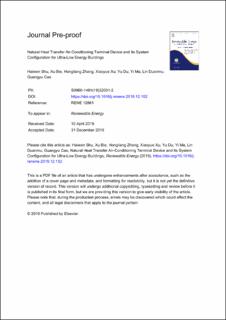| dc.contributor.author | Shu, Haiwen | |
| dc.contributor.author | Bie, Xu | |
| dc.contributor.author | Zhang, Hongliang | |
| dc.contributor.author | Xu, Xiaoyue | |
| dc.contributor.author | Du, Yu | |
| dc.contributor.author | Ma, Yi | |
| dc.contributor.author | Duanmu, Lin | |
| dc.contributor.author | Cao, Guangyu | |
| dc.date.accessioned | 2021-09-28T06:20:56Z | |
| dc.date.available | 2021-09-28T06:20:56Z | |
| dc.date.created | 2020-11-12T12:18:42Z | |
| dc.date.issued | 2020 | |
| dc.identifier.citation | Renewable Energy. 2020, 154 1113-1121. | en_US |
| dc.identifier.issn | 0960-1481 | |
| dc.identifier.uri | https://hdl.handle.net/11250/2783878 | |
| dc.description.abstract | In consideration of the lowered heating and cooling load of ultra-low energy buildings, a natural heat transfer air-conditioning terminal device (NHTACTD) is presented by the authors. The terminal device is able to undertake heating, cooling and moisture load of a room according to the inlet water temperature. Its comparative advantages are pointed out by comparing it with radiators, fan coil units, chilled beams and radiant heating and cooling terminals. After the actual thermal properties of the NHTACTD are provided, three air-conditioning system configuration schemes based on the NHTACTDs are presented: (1) In the NHTACTDs plus fresh air system, the NHTACTDs and the fresh air handling unit undertake all the air-conditioning load of the system together, and it is used where high indoor air quality is demanded; (2) In the scheme of the air-conditioning system including the NHTACTDs only, all the air-conditioning load of the system has to be undertaken by the terminals alone and it is used where high indoor air quality is not rigidly demanded. (3) In the scheme of the air-conditioning system including both the NHTACTDs and radiant panels, the NHTACTDs undertake all the moisture load of the system, and the remaining sensible cooling load is undertaken by the radiant panels. The scheme can be used where there is large sensible cooling load while high indoor air quality is not rigidly demanded. Then an ultra-low energy residential building is taken as a case project to elaborate the design method of an air-conditioning configuration scheme based on the terminal device with the help of psychrometric chart. | en_US |
| dc.language.iso | eng | en_US |
| dc.publisher | Elsevier | en_US |
| dc.rights | Attribution-NonCommercial-NoDerivatives 4.0 Internasjonal | |
| dc.rights.uri | http://creativecommons.org/licenses/by-nc-nd/4.0/deed.no | |
| dc.title | Natural heat transfer air-conditioning terminal device and its system configuration for ultra-low energy buildings | en_US |
| dc.type | Peer reviewed | en_US |
| dc.type | Journal article | en_US |
| dc.description.version | acceptedVersion | en_US |
| dc.rights.holder | This is the authors' accepted manuscript to an article published by Elsevier. Locked until 1.1.2022 due to copyright restrictions. The AAM is made available under the CC-BY-NC-ND 4.0 license http://creativecommons.org/licenses/by-nc-nd/4.0/ | en_US |
| dc.source.pagenumber | 1113-1121 | en_US |
| dc.source.volume | 154 | en_US |
| dc.source.journal | Renewable Energy | en_US |
| dc.identifier.doi | 10.1016/j.renene.2019.12.152 | |
| dc.identifier.cristin | 1847372 | |
| cristin.ispublished | true | |
| cristin.fulltext | original | |
| cristin.qualitycode | 1 | |

